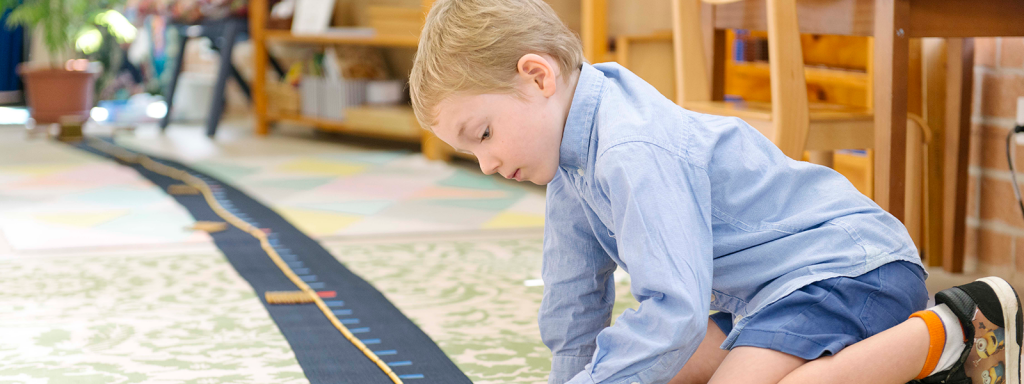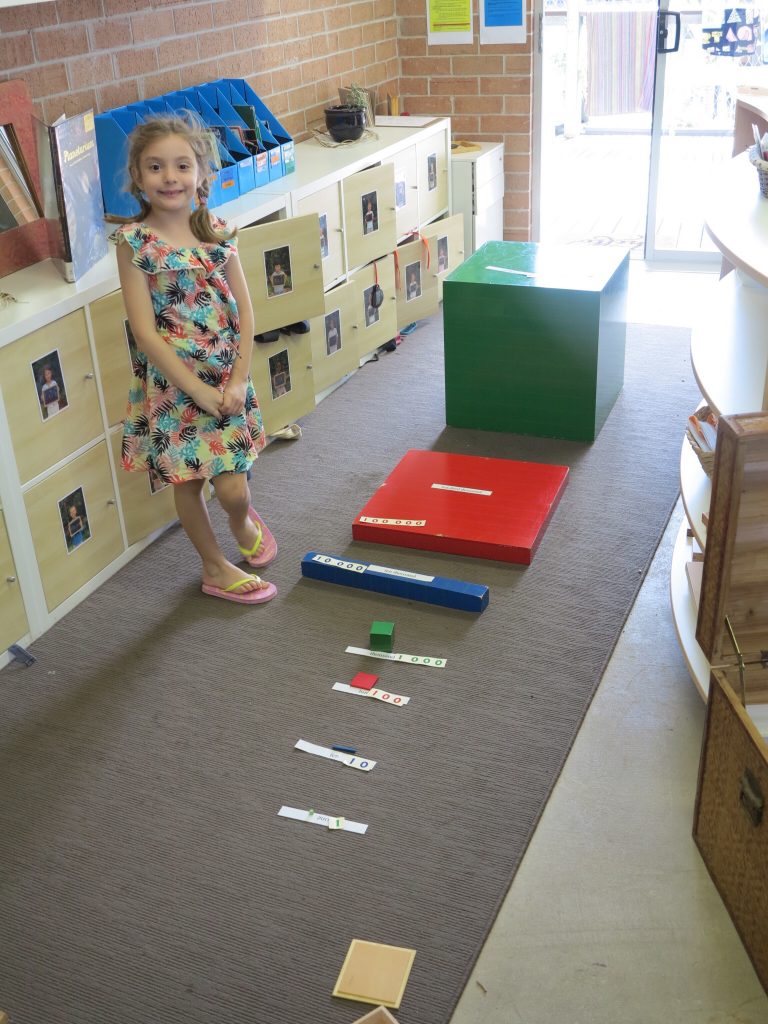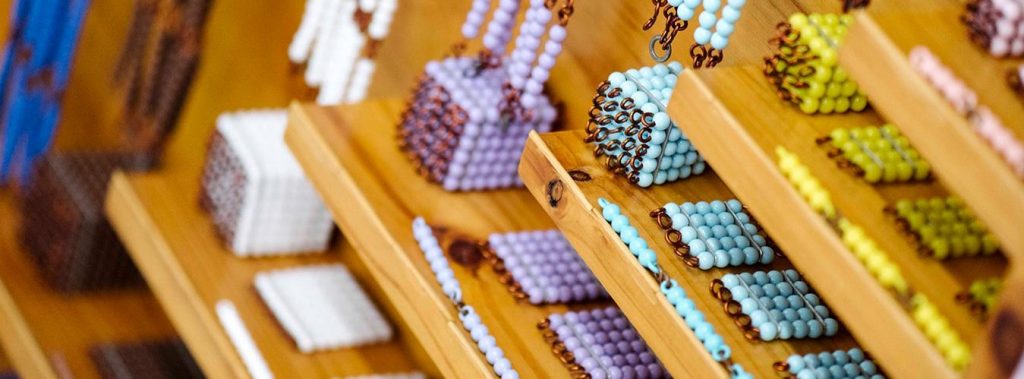“These two powers of the mind (imagination and abstraction), which go beyond the simple perception of things actually present, play a mutual part in the construction of the mind’s content. A precise alphabet, on the one hand, and grammatical rules on the other, permit an indefinite accumulation of the wealth of words.
~Maria Montessori, The Absorbent Mind, p 184-5
“In our work, therefore, we have given a name to this part of the mind which is built up with exactitude, and we call it the ‘mathematical mind’. I take the term from Pascal, the French philosopher, physicist and mathematician, who said that man’s mind was mathematical by nature, and that knowledge and progress came from accurate observation.”
Can you picture a million match sticks? What about a million grains of sand? How tall would that sandcastle be?
It’s easy to see how hard it is for a child to imagine these things. It’s why those ‘how many Easter Eggs are in the jar’ competitions are always so challenging. We have a mental barrier against it, often because we didn’t have any opportunity to stretch our minds for this way of thinking.
It starts with concrete
One of the many standout features of a Montessori education is that early years sensorial learning is based on concrete concepts – which are then gradually replaced with abstract thinking in the primary years. It’s the opposite of how many of us were taught at school and can take some getting used to.
One way to think of it is that all of those math materials you see on the shelves in the early years are actually ‘materialised abstractions’. That is, Dr Montessori has taken an abstract concept – such the decimal system – and developed a concrete, material basis for learning (that is, something the child can actually hold in their hands, like the Golden Beads). In this way, children learn the concept way before they are expected to engage in abstract activities, like working out math problems with pencil and paper or in their heads.

In fact, the entire purpose of the early years Montessori math curriculum is to make the abstract concrete, so that children can see and understand each concept clearly in their mind.
From the Red and Blue Rods (where children arrange the rods from smallest to largest and see the relationship of numbers from 1 through to 10), through to Spindle Boxes (which introduce the concepts of zero and quantity), Numeral Cards and Counters (associating numerals with number of objects) to the Golden Beads (introducing the Decimal System), materials steadily take children along a continuum of learning that is not hampered by the use of pen and paper – a different skill set altogether.
Math materials then introduce the four operations (addition, subtraction, multiplication and division) and place value. These include the Stamp Game, Bead Materials (for skip counting and eventually squaring and cubing), Strip Boards and Bead Boards, Finger Boards, The Snake Game, The Bead Frames, The Dot Game and the Checkerboard right through to Cubing Materials (the Binomial and Trinomial Cube). (We’ll do a separate blog on the Binomial and Trinomial cubes and how they are used from the Early Years right through to High School – it’s truly amazing!).
And of course maths isn’t just about operations – Montessori students also learn about geometry and fractions from an early age – in particular the relationship between fractions and division.
A journey to abstraction
It is once children enter the second plane (6-12 yrs) that the journey from concrete to abstract starts to take hold.
Step by step, working through the continuum of materials, children are challenged to move from using concrete materials to using their knowledge of math facts and abstract thinking to solve simple math problems in their mind. It comes easy to them by then, as the concepts have already been well understood. It’s not about making sense of numerals on a page – and then trying to picture in their mind what 7 times 7 looks like, for example. They can picture what 7 times 7 looks like – they’ve counted out the unit stamps with the Stamp Game. They’ve watched the seven chain stretch out across the classroom floor. They’ve counted out seven 7-bead bars with the Checkerboard and then counted them to get the result. Moving to paper and pen is easy when you understand what is really going on.
Of course, it’s not just with math that children are challenged to think in the abstract in the second plane.
A core foundation of the primary years in Montessori is the concept of ‘impressionistic’ lessons. These are stories designed to spark the child’s imagination and interest in further study. The Five Great Lessons are well known in the Montessori world and are core to student learning in the 6-9 and 9-12 environments. There are also a number of other key lessons embedded within the Great Lessons as well.
One of these key lessons is the Wooden Hierarchial Material.
We love big numbers!
If you’ve ever seen a Montessori primary environment, you may have noticed a huge green cube in the classroom and wondered what it is for.
Primary aged children love working with big numbers and big problems and this material harnesses that excitement. While traditional math programs start children with very small numbers, slowly working their way up to bigger numbers, in Montessori we go BIG! Even the Golden Beads introduced in the Early Years quickly have children involved in addition and combining numbers into the thousands. By primary, students work into the millions and beyond.

The Hierarchial Material gives children the ‘key’ to the entire decimal system – representing the quantity of one (with one tiny unit cube), ten, hundred, thousand, ten thousand, hundred thousand, and million (hence the big green cube). It also introduces three families of numbers – the family of units, the family of thousands and the family of millions.
So the answer to ”What would one million look like?” is answered and the groundwork is laid for students to eventually work in complete abstraction – with a true understanding of mathematical concepts.
Maths in the real world
While the Hierarchial Material is just one example of the many math materials in a Montessori classroom, it demonstrates the importance of harnessing a child’s interest into mathematical exploration. Who wouldn’t enjoy maths when you get to use hands-on materials and the sky is the limit with how far you want to go?
In our Adolescent Community, this interest is further explored through the application of mathematical concepts in the real world. Our innovative setting and developmentally responsive curriculum provides opportunities for students to learn in real world contexts through meaningful work and real-life problem solving. This culminates in mathematics studies that has a focus on developing sophisticated mathematical reasoning and critical thinking, rather than performing routine operations.
To find out more about our Math curriculum and how Math is taught the Montessori way, come along on a College tour and see it for yourself! We are currently accepting early years applications for 2021 and beyond.
